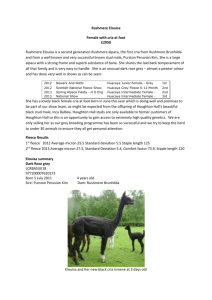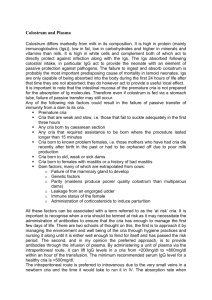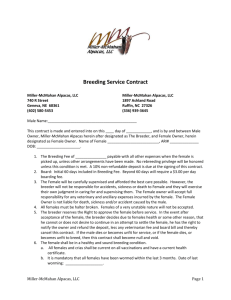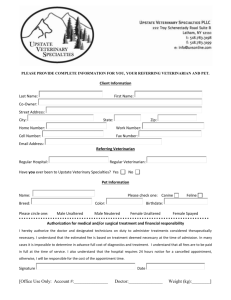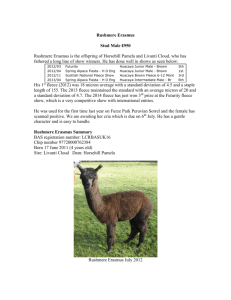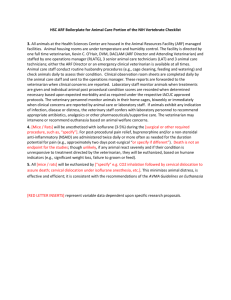Llama and Alpaca Cria Care Sheet
advertisement
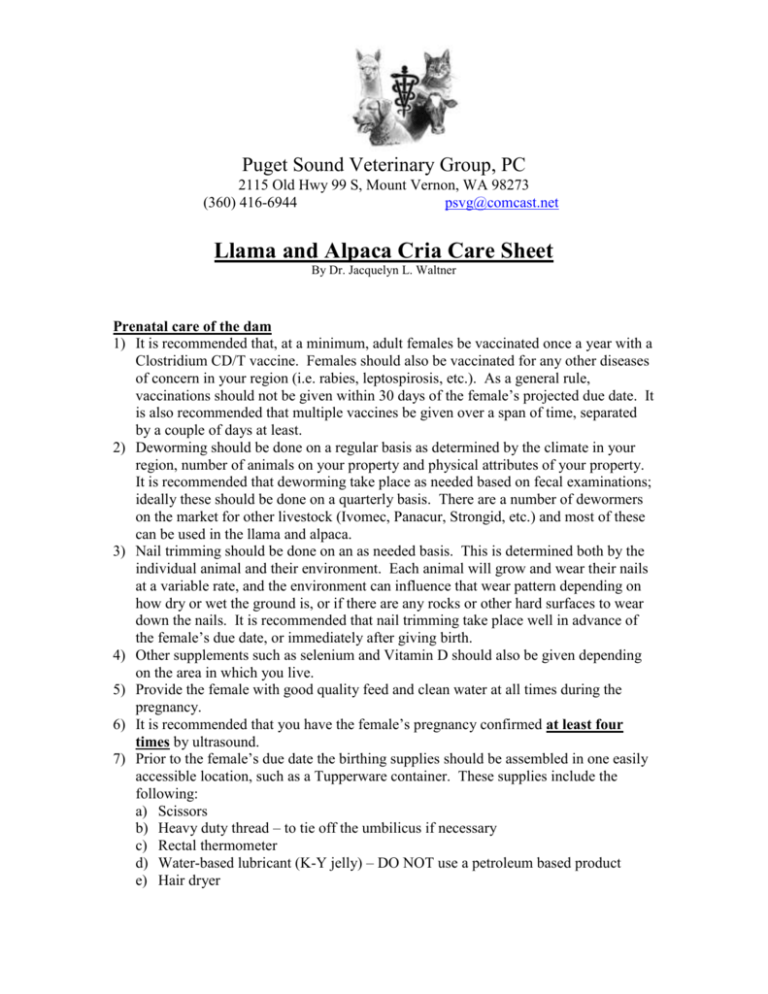
Puget Sound Veterinary Group, PC 2115 Old Hwy 99 S, Mount Vernon, WA 98273 (360) 416-6944 psvg@comcast.net Llama and Alpaca Cria Care Sheet By Dr. Jacquelyn L. Waltner Prenatal care of the dam 1) It is recommended that, at a minimum, adult females be vaccinated once a year with a Clostridium CD/T vaccine. Females should also be vaccinated for any other diseases of concern in your region (i.e. rabies, leptospirosis, etc.). As a general rule, vaccinations should not be given within 30 days of the female’s projected due date. It is also recommended that multiple vaccines be given over a span of time, separated by a couple of days at least. 2) Deworming should be done on a regular basis as determined by the climate in your region, number of animals on your property and physical attributes of your property. It is recommended that deworming take place as needed based on fecal examinations; ideally these should be done on a quarterly basis. There are a number of dewormers on the market for other livestock (Ivomec, Panacur, Strongid, etc.) and most of these can be used in the llama and alpaca. 3) Nail trimming should be done on an as needed basis. This is determined both by the individual animal and their environment. Each animal will grow and wear their nails at a variable rate, and the environment can influence that wear pattern depending on how dry or wet the ground is, or if there are any rocks or other hard surfaces to wear down the nails. It is recommended that nail trimming take place well in advance of the female’s due date, or immediately after giving birth. 4) Other supplements such as selenium and Vitamin D should also be given depending on the area in which you live. 5) Provide the female with good quality feed and clean water at all times during the pregnancy. 6) It is recommended that you have the female’s pregnancy confirmed at least four times by ultrasound. 7) Prior to the female’s due date the birthing supplies should be assembled in one easily accessible location, such as a Tupperware container. These supplies include the following: a) Scissors b) Heavy duty thread – to tie off the umbilicus if necessary c) Rectal thermometer d) Water-based lubricant (K-Y jelly) – DO NOT use a petroleum based product e) Hair dryer f) Iodine or chlorhexidine – for spraying/dipping the navel g) Container for the iodine or chlorhexidine – spray bottle (to spray the navel) or film container (to dip the navel) h) Cria blanket – these can be purchased from Stevens Llama Tique i) Enema bottle (optional) j) Towels k) Plastic feeding bottle and lamb nipples, feeding tubes for tube feeding l) Weight scale capable of reading weight in 0.2 pound increments m) Frozen colostrum or plasma (kept in the freezer) – this is a product which farms in a specified area may choose to bank at one location – available to everyone in the area if the need arises. Birthing 1) If this is one of your first cria you may want to notify your veterinarian of the anticipated due date(s). 2) It is recommended that you place the pregnant female in an easily visualized pasture at least one month prior to her due date. 3) Signs associated with impending birth may include the following: a) Humming b) Frequent urination or defecation c) Shifting or rolling from side to side d) Not eating or chewing her cud e) Ears laid back f) Prolonged periods spent lying down g) Frequent rising and lying down ** Not all females will show all of these signs. 4) If at any time you notice any signs of discomfort or pain (rolling completely over, biting/chewing at the abdomen, straining) you should call the veterinarian immediately. 5) Once active labor begins the female should deliver the cria within 30-45 minutes. If a cria has not been delivered within this time, your veterinary office should be called immediately. 6) Most females will birth from mid-morning to late afternoon (9AM-5PM) and will deliver their cria without a problem. Cria Care 1) How to proceed with the cria and dam depends on the season and the weather. a) If it is below 68ºF (19 C), raining, or snowing: i) Move the cria and the dam inside to a dry, well-lit, warm and clean location. (If you pick up the newborn cria, the dam will usually follow without a problem.) ii) Dip or spray the umbilicus (navel) with iodine or chlorhexidine. Repeat this two more times before the cria is 8 hours old. iii) Towel dry the cria. Puget Sound Veterinary Group, PC 2115 Old Hwy 99 S, Mount Vernon, WA 98273 (360) 416-6944 psvg@comcast.net iv) Check the cria’s breathing. If it is having difficulty, make sure to clear away any fetal membranes from around the nose and mouth. If the difficulty persists, call your veterinarian’s office immediately. v) Check the cria’s temperature. This should be done twenty minutes after the cria is born, or immediately, if you were not present for the birth. (1) If the temperature is greater than 99.5ºF (35 C) the dam and cria may be left alone to bond. (2) If the temperature is less than 99.5ºF (35 C) but greater than 98ºF, the cria needs to be warmed up until it does have a temperature greater than 99.5ºF. (a) Completely dry the cria – use a hair dryer (on low or medium heat). Place a dry towel over the cria and direct the warm air under the towel, making sure that the air is not so warm that it could burn the cria. Also, rub the cria to help stimulate it and get its blood moving. (b) Place the cria under a heat lamp. These two steps are typically sufficient to raise the temperature of a cria with the listed temperature range. In the event that they do not (within 20 minutes), the following steps should be taken… (c) If the cria’s temperature is still not greater than 99.5ºF: (i) Fill a deep sink with hot tap water, 103-105ºF (36.5-37.5 C). (ii) Place the cria inside 2 large plastic garbage sacks, with its head out. (iii)Place the cria in the sink, submerging its body while holding its head out of the water, for 10-15 minutes at a time. (iv) Check its temperature each time the cria is removed from the bath, until its temperature is greater than 99.5ºF. (v) Dry the cria if necessary. (vi) Recheck the cria’s temperature 15-20 minutes after removal from the bath to make sure that the cria is stable and regulating its temperature. (vii) Once its temperature is stabilized, leave the cria and dam alone to bond. b) If it is greater than 68ºF and good weather the cria and dam can remain outside in the field. Make sure to follow the steps listed above, beginning with dipping or spraying the umbilicus. 2) Check the dam’s udder for milk – squeeze a small amount of colostrum (the first milk) from each teat. If you cannot express any milk, please call the veterinarian’s office. 3) Make sure that the dam passes the placenta; she should do so within 4 hours. Once it passes make sure that there are no missing pieces; do this by laying out the placenta and making sure that it looks continuous. If it does not pass within 8 hours or there are missing pieces, contact your veterinarian. DO NOT pull on the placenta once it begins to be expelled, it could have life-threatening repercussions. Allow the dam and gravity to accomplish the task. 4) The cria should be standing within 1 hour of birth – typically less. If it is not standing within 1 hour, try assisting it. Call your veterinarian if it continues to have problems. 5) The cria should be nursing within 2 hours of birth. Make sure to watch it for nursing since this is how it will acquire its initial antibodies to fight disease. If it is not nursing within 3 hours, try assisting it to locate the teats. If necessary feed the cria colostrum; this can be milked from the dam, or obtained from a cow, goat, llama or alpaca. If the colostrum is from cow or goat origin, make sure that the source is free of disease (i.e. Johnes, CAE, etc.). If colostrum can not be obtained, frozen llama plasma can be thawed and fed to the cria. 6) Once the cria and dam have had time to bond: a) Weigh the cria. b) Give the cria an enema to facilitate passage of the meconium. This is optional since most cria will pass it without assistance; but it is important to know that the meconium has been passed. Fleet enemas, which can be purchased at most grocery stores or pharmacies, should not be used with the original fluid. Instead, dump out the fluid and replace with warm water and 1 or 2 drops of liquid dish soap. 7) Within the first week of life: a) Your veterinarian should come out to examine the dam and cria to make sure they are both doing well. At that time blood for an IgG test can be drawn and a microchip implanted. If you are planning to insure the cria this is an excellent time for the insurance exam. b) If the cria is born between October and March, it should be supplemented with Vitamin D. There are both oral and injectable products on the market. The oral product needs to be given every 2 weeks while the injectable needs to be given every 2 months. Contact your veterinarian for the appropriate dosing. 8) Recommendations: a) Vaccinate for Clostridium Type C, D and Tetanus. Contact your veterinarian to determine the protocol that is right for your farm. b) Vaccinate for any other diseases of concern in your area (EHV-1, Rabies, Leptospirosis, etc.). Again, check with your veterinarian to determine which vaccines are necessary for your farm. c) Cria should be monitored closely for intestinal parasites. Check with your veterinarian for scheduling and other recommendations for your farm. d) Selenium supplementation – discuss with your veterinarian whether this is important for you area. 9) Important phone numbers: a) Puget Sound Veterinary Group, (360) 416-6944 b) PSVG Emergency Line, (360) 428-7144
